Osteospermum incanum subsp. incanum
Osteospermum incanum Burm.f. subsp. incanum (= Chrysanthemoides incana (Burm.f.) Norl.)
Family: Asteraceae
Common names: grey bietou, grey tick berry (Eng.); grysbietou, fynbietou, vaalsandbietou, vaalbietou, vaalbitou (Afr.)
Introduction
A vigorous, sprawling, densely-branched, low-growing grey shrub that is suitably equipped to beautify coastal and interior gardens alike. Its grey leaves, bright yellow daisies flowering sporadically throughout the year and little appetite for water, are some of its main attributes.
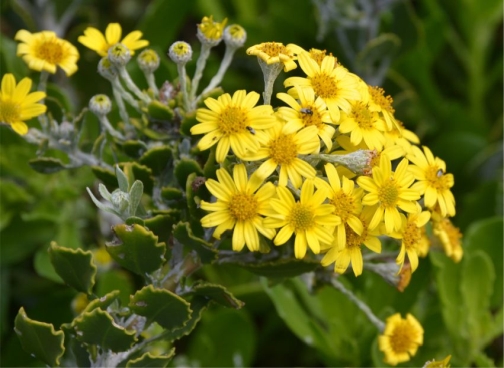
Description
Description
Osteospermum incanum subsp. incanum is a semi-prostrate bush, 0.8-1.5 m tall, that can spread up to 4 m². The toothed, woolly grey leaves are up to 20 mm in length and 7-10 mm in width and have short, thorny growths on the tips. The undersides of the leaves are hairy, while the upper sides are smooth. In younger leaves both sides are covered in grey hairs.
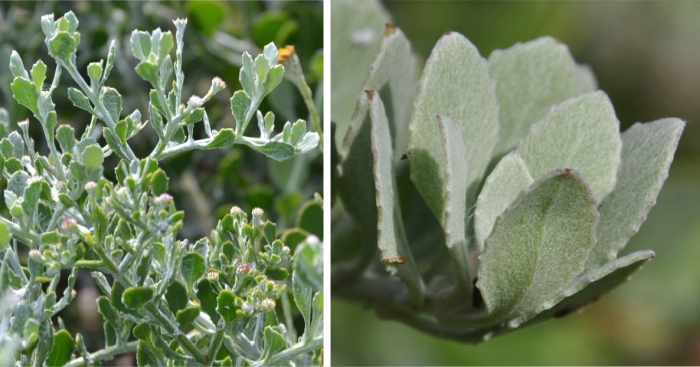
The flowerheads are 15-20 mm in diameter with both disc and ray florets yellow. These are often borne in small clusters at the stem-tips. Flowering is mainly during summer, from December to May and sporadically throughout the year. From the fertilised flowers, the oval, fleshy fruitlets develop, 5 mm wide and 7 mm long, pale-green ripening purplish black. Seeds from 2 mm in width and 5 mm in length, develop to maturity from midwinter to spring (July to October).
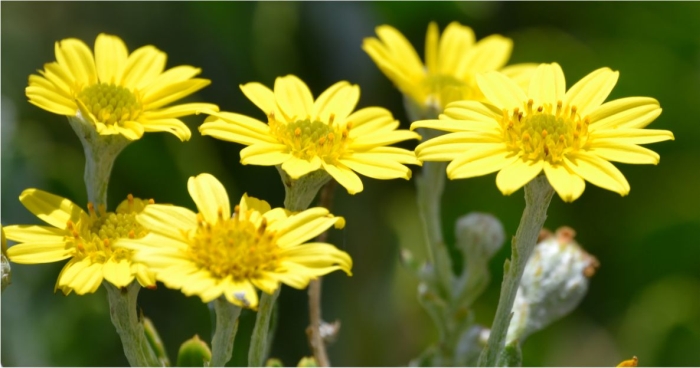
Conservation Status
Status
The Red List of South African Plants website lists the conservation status of this widespread species as Least Concern (LC).
Distribution and habitat
Distribution description
The grey tick berry favours coastal dunes and sandy inland slopes, in a variety of vegetation types including Langebaan Dune Strandveld, Peninsula Shale Renosterveld, Cape Flats Fynbos, Namaqualand Sand Fynbos and Namaqualand Coastal Duneveld. The distribution range stretches from Namibia, through the Northern Cape to the Bredasdorp area in the Overberg region of the Western Cape Province of South Africa.
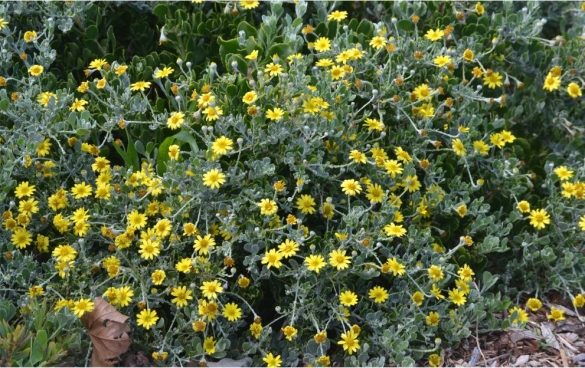
Derivation of name and historical aspects
History
The generic name Osteospermum is derived from the Greek osteon for ‘bone’ and sperma meaning ‘seed’ in reference to the hard fruits. The species name incanum is Latin for ‘grey’ and describes the leaf-colour.

The genus Osteospermum forms part of the Asteraceae, the largest plant family in southern Africa with approximately 2 500 species. Plants in the Asteraceae are popular in several industries, and include herbs, medicines, foodplants, oil producers, insecticides and ornamentals. Osteospermum, with several other well-known genera including Dimorphotheca and Tripteris, falls under the Tribe Calenduleae. There are 118 species in this tribe. There are about 80 species of Osteospermum, widely distributed through Africa with 3 species between the Middle East (2) and St Helena (1).
This species used to be classified in the genus Chrysanthemoides, which it shared with one other species, C. monilifera. This genus was formed in 1943 when T. Norlindh moved these two species from the genus Osteospermum to their own genus, because of their unusual fleshy fruit (drupe), that markedly differs from other species of Osteospermum. This was almost 200 years after Linnaeus named the first of these two species, Chyrsanthemoides monilifera as Osteospermum moniliferum. In 2012 the two species were moved back to Osteospermum.
In the Cederberg-region there are at least 4 local species known as bietou: Osteospermum incanum, O. moniliferum, Tripteris sinuata and T. oppositifolia. This name was also given to one of the most well-known areas in the region, the Biedouw-Valley. It is not certain after which bietou species it was named. This valley is also renowned for its mass floral displays of annuals after good winter rains.
There are 2 subspecies of Osteospermum incanum: the subsp. incanum (as described in this article) and subsp. subcanescens (DC.) J.C.Manning & Goldblatt (previously Chrysanthemoides monilifera (L.) Norl. subsp. subcanescens (DC.) Norl.). The latter is a perennial shrub between 1-3 m tall, found at altitudes of 15–1 219 m above sea-level in the Western and Eastern Cape. It differs from subsp. inancum in having no hairs, or scarce hairs, on its stems, leaves and infloresence.
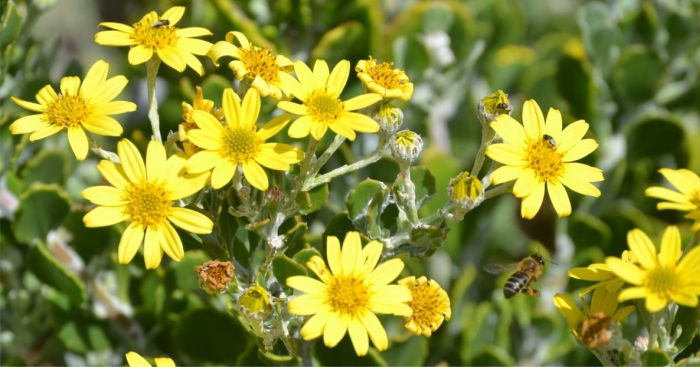
Ecology
Ecology
Bees and other flying insects are observed visiting the flowers of this species, as a food-source. It is not known whether they also fulfil a role of pollination. This species is useful as fodder for animals in the dry areas of the winter rainfall region. This fast-growing species is also recommended for planting where the veld has been denuded due to over-grazing.
The seed shapes of species of Osteospermum are markedly different due to their method of dispersal. Ant-dispersed seed has an oily, fleshy body in one side; those that are adapted for wind-dispersal are winged, while with this species, birds get rewarded with a fleshy purple outer layer for its role in dispersal.
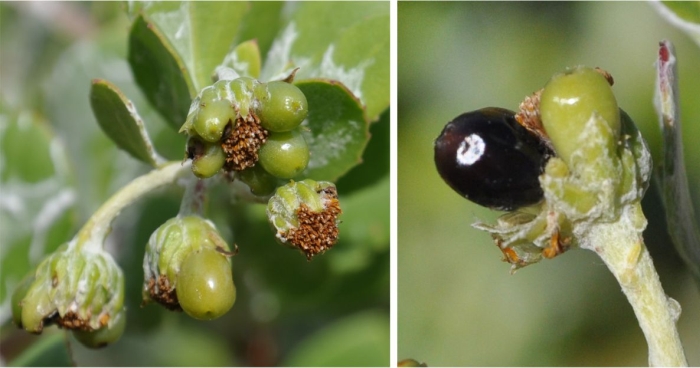
Uses
Use
There are no medicinal or cultural uses recorded for this species. This species is well-known in the ornamental horticultural trade.
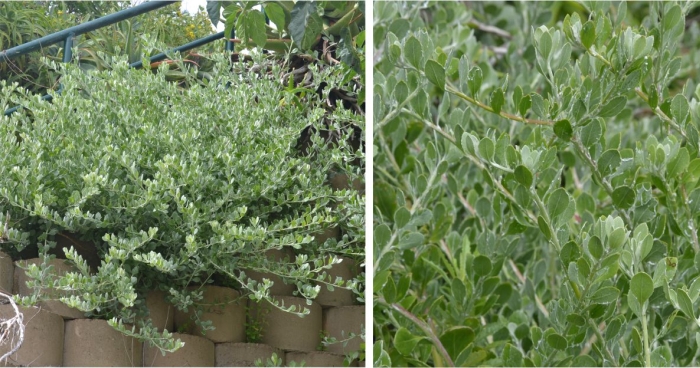
Growing Osteospermum incanum subsp. incanum
Grow
No published knowledge is available on seed propagation for this species. Since it is found over such a wide distribution range, it is possible that germination may differ and may require pre-germination treatments such as smoke (in fynbos habitats) to after-ripening (in Mediterranean-climate regions on South Africa’s West Coast towards Namibia).
The grysbietou can be propagated vegetatively through cuttings. Take stem-cuttings of 70-100 mm long in autumn. Remove the bottom two-thirds of the leaves. Dip the cuttings in a rooting hormone suitable for herbaceous perennials and shrubs, and place in a prepared tray filled with the rooting-medium. This medium must remain moist and never dry out. Once rooted, cuttings can be potted in a larger pot or directly transplanted into the garden during the rainy season
This species stands out in mass mixed plantings with other annual species, in small to much larger flower beds or rockeries. It can also aesthetically soften construction or hard landscaping elements such as gabions or retaining walls. The natural habitat of this species transcends several vegetation-types such as dune strandveld, coastal duneveld, sand fynbos or shale renosterveld. Species which often share a habitat with the grey bush-tick berry, include: Pterocelastrus tricuspidatus, Searsia lucida, Metalasia densa, Diosma hirsuta, Erica corifolia, E. ferrea, E. imbricata, E. mammosa, E. plumosa, E. pulchella and E. baccans, Eriocephalus africanus var. africanus and E. racemosus, Helichrysum cymosum, Leucadendron floridum and L. salignum, Leucospermum hypophyllocarpodendron subsp. canaliculatum, Plecostachys serpyllifolia, Protea scolymocephala, Myrsine africana , Olea europaea subsp. africana , Lobostemon argenteus, Salvia africana and S. aurea, Pteronia divaricata, Roepera morgsana, Ballota africana, Chironia baccifera, Euphorbia burmannii, E. brachiata and E. mauritanica, Pelargonium fulgidum, Ruschia caroli and R. cymosa, Tetragonia fruticosa, Carpobrotus acinaciformis and C. edulis, Conicosia pugioniformis subsp. pugioniformis, Didelta carnosa var. tomentosa, Jordaaniella dubia, Melianthus elongatus, Chrysocoma ciliata, Dimorphotheca pluvialis, Arctotis hirsuta, Cleretum bellidiforme, Heliophila coronopifolia, Carpanthea pomeridiana, Senecio littoreus, S. elegans and S. arenarius.
This is a relatively pest-free species with no known pests and diseases.
Plants can be given a hard cut-back during the year to neaten its appearance.
References
- Bean, A. & Johns, A. 2005. Stellenbosch to Hermanus. South African Wild Flower Guide 5. Botanical Society of South Africa, Cape Town.
- Klopper, R.R., et al. 2006. Checklist of the flowering plants of sub-Saharan Africa: An index of accepted names and synonyms. Southern African Botanical Diversity Network report No 42. SABONET.
- Koekemoer, M., Steyn, H.M. & Bester, S.P. 2015. Guide to Plant Families of southern Africa. Strelitzia 31. 2nd ed., 2nd print. South African National Biodiversity Institute, Pretoria, South Africa.
- Manning, J, & Goldblatt, P. 1996. West Coast. South African Wild Flower Guide 7. Botanical Society of South Africa, Cape Town
- Manning, J. & Goldblatt, P. 2012. Plants of the Greater Cape Floristic Region 1: the Core Cape Flora. Strelitzia 29. South African National Biodiversity Institute, Pretoria.
- Mucina, L., et al. 2006. Succulent Karoo Biome. In: L. Mucina & M. Rutherford (eds.), Vegetation map of South Africa, Lesotho and Swaziland. South African National Biodiversity Institute.
- Powrie, L. 2004. Common names of Karoo plants. Strelitzia 16. National Botanical Institute, Pretoria.
- Raimondo, D., Von Staden, L., Foden, W., Victor, J.E., Helme, N.A., Turner, R.C., Kamundi, D.A. & Manyama, P.A. (eds) 2009. Red list of South African plants. Strelitzia 25. South African National Biodiversity Institute, Pretoria.
- Rebelo, A.G., Boucher, C., Helme, N., Mucina, L. & Rutherford, M.C. 2006. Fynbos Biome. In: Mucina, L. & Rutherford, M.C. (eds.), The vegetation of South Africa, Lesotho and Swaziland. Strelitzia 19. SANBI, Pretoria.
- Stearn, W. 2002. Stearn's dictionary of plant names for gardeners. Timber Press, Portland, Oregon.
- Trinder-Smith, T.H. 2003. The Levyns Guide to the plant genera of the south western Cape. Bolus Herbarium, UCT, Red Roof Design CC, Cape Town
- Van Breda, P.A.B. & Barnard, S.A. 1991. 100 Veld plants of the winter-rainfall region: a guide to the use of veld plants for grazing. Bulletin no. 422. Dept. of Agriculture Development, Cape & Transvaal Printers for the Government Printer, Pretoria.
- Van Rooyen, G. & Steyn, H. 1999. Cederberg Clanwilliam & Biedouw Valley South African wildflower guide 10. Botanical Society of South Africa, Cape Town.
- Vlok, J. & Schutte-Vlok, A-L. 2015. Plants of the Klein Karoo. Umdaus Press, Hatfield.
Credits
Roger Oliver
Kirstenbosch National Botanical Garden
April 2023
Plant Attributes:
Plant Type: Scrambler, Shrub
SA Distribution: Northern Cape, Western Cape
Soil type: Sandy, Loam
Flowering season: Early Summer, Late Summer
PH: Acid, Neutral
Flower colour: Yellow
Aspect: Full Sun
Gardening skill: Easy
Special Features:
Horticultural zones










Rate this article
Article well written and informative
Rate this plant
Is this an interesting plant?
Login to add your Comment
Back to topNot registered yet? Click here to register.